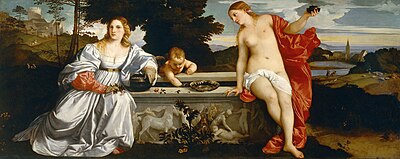 Renaissance art is the painting, sculpture and decorative arts of that period of European history known as the Renaissance, emerging as a distinct style in Italy in about 1400, in parallel with developments which occurred in philosophy, literature, music and science. Renaissance art, perceived as a royalty of ancient traditions, took as its foundation the art of Classical antiquity, but transformed that tradition by the absorption of recent developments in the art of Northern Europe and by application of contemporary scientific knowledge. Renaissance art, with Renaissance Humanist philosophy, spread throughout Europe, affecting both artists and their patrons with the development of new techniques and new artistic sensibilities. Renaissance art marks the transition of Europe from the medieval period to the Early modern age.
Renaissance art is the painting, sculpture and decorative arts of that period of European history known as the Renaissance, emerging as a distinct style in Italy in about 1400, in parallel with developments which occurred in philosophy, literature, music and science. Renaissance art, perceived as a royalty of ancient traditions, took as its foundation the art of Classical antiquity, but transformed that tradition by the absorption of recent developments in the art of Northern Europe and by application of contemporary scientific knowledge. Renaissance art, with Renaissance Humanist philosophy, spread throughout Europe, affecting both artists and their patrons with the development of new techniques and new artistic sensibilities. Renaissance art marks the transition of Europe from the medieval period to the Early modern age.- Leonardo da Vinci
- Born: April 15, 1452, Vinci, Italy
- Died: May 2, 1519, Amboise, France
- Periods: High Renaissance, Pastel Art
- Donatello
- Born: 1386, Florence, Italy
- Died: December 13, 1466, Florence, Italy
- Periods: Italian Renaissance, The Renaissance
Ven azir s rio from Rio Ven





